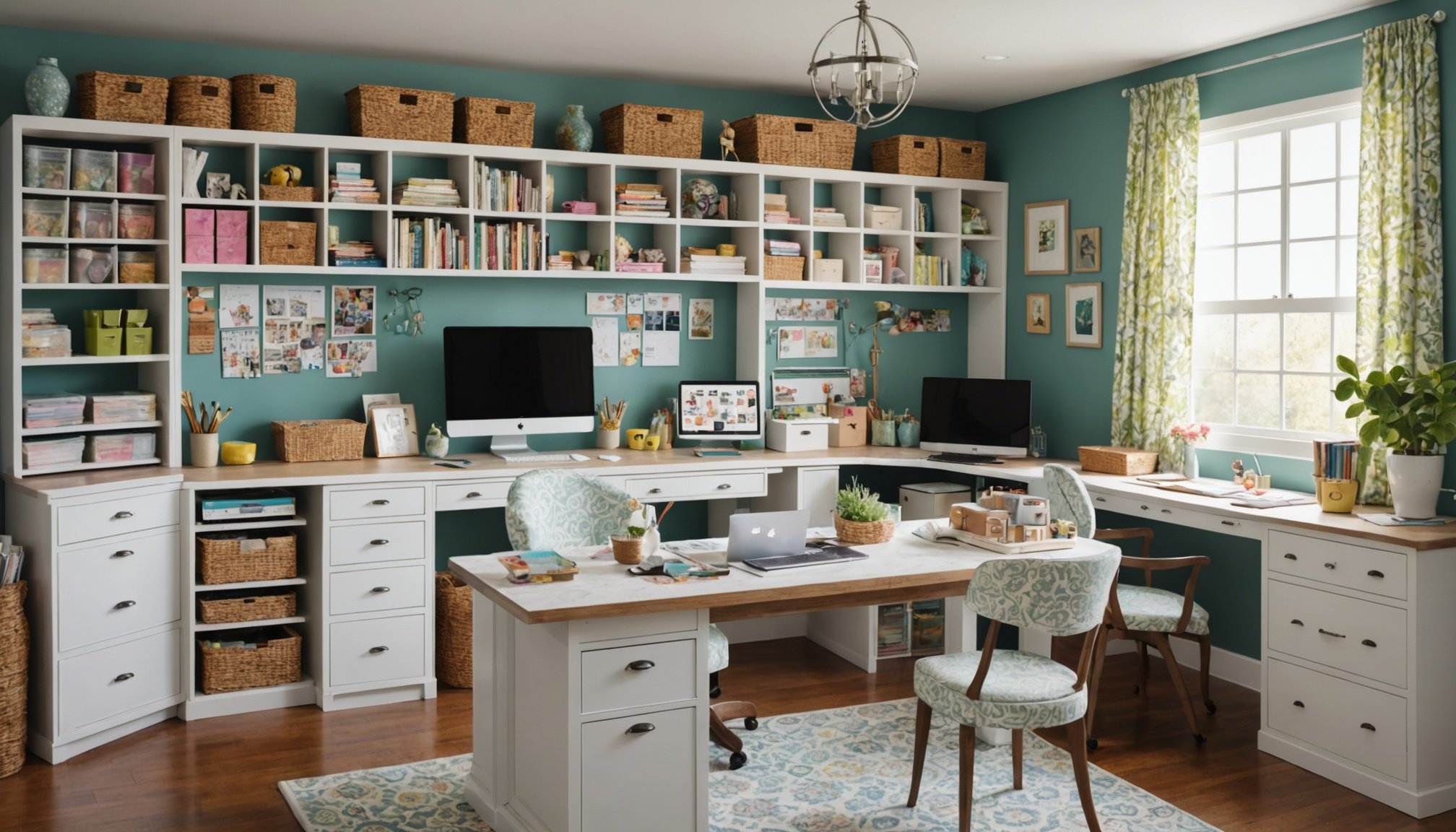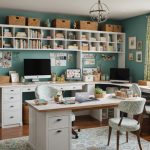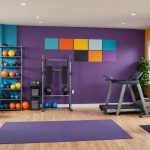Understanding Your Craft Room Needs
Designing a craft room tailored to your personalized design and creative flow preferences starts with introspection. Assess your crafting habits by listing the activities you regularly engage in—be it sewing, painting, or scrapbooking. This will help you identify the craft room essentials specific to your needs. For example, a seamstress may put a high value on having a spacious cutting table and adequate fabric storage, while a painter might prioritise ample natural lighting and easy-to-clean surfaces.
When it comes to functionality, consider features that enhance your creative flow. If your work involves multiple crafting activities, adaptable storage systems that can easily shift between tasks become crucial. This approach ensures all your tools and materials are within arm’s reach, maximising efficiency.
Also to discover : Transform Your Home Gym: Crafting a Vibrant Color Palette to Enhance Focus and Energy
Tailor the space to accommodate your creative pursuits by employing personalized design elements. This could include adjustable shelving for versatile storage and a dedicated work zone for each activity. Use dividers or strategic furniture placement to create sub-zones within the room, maintaining focus and organisation. As your crafting interests evolve over time, so too should your craft room. Keep it adaptable and reflective of your vibrant, ever-changing creativity.
Design Ideas for a Creative Sanctuary
Creating a sanctuary for your crafting adventures involves merging style with utility to achieve a seamless balance. When designing, consider various aesthetic influences such as modern, rustic, or eclectic styles. Each offers unique functional layouts that can cater to different crafting needs. A modern design might incorporate sleek lines and minimalist elements, while a rustic approach could use natural materials and cozy textures.
This might interest you : Innovative Ideas for Designing a Safe and Enjoyable Toddler Play Area in a Small Apartment
To maintain aesthetic appeal, it’s crucial to balance beauty with practicality. Ensure your space is both visually pleasing and efficiently organised. Clever use of colour palettes, textures, and patterns can harmonise your craft room, making it a vibrant yet orderly haven.
Thoughtful creative zoning enhances adaptability, especially if you engage in multiple crafting functions. Define areas for specific activities like sewing, painting, or sculpting. This delineation fosters concentration and prevents workspaces from becoming cluttered.
Ultimately, the goal is to cultivate a space that inspires while also being supremely functional. Tailor each element to support both your artistic vision and practical requirements, creating an environment that’s both a creative sanctuary and a pragmatic workspace.
Organisation and Storage Solutions
Creating an organised craft room is pivotal to cultivating a productive and inspiring environment. Begin by considering your storage systems: effective shelving and cabinetry are indispensable. Opt for adjustable shelves, which can accommodate a variety of materials, and install cabinets with transparent doors to provide easy access and visibility of your supplies.
Maximise your space by utilising vertical storage solutions. Install wall-mounted racks or pegboards to keep frequently used tools within arm’s reach, freeing up valuable workspace. This approach not only declutters the area but also enhances visual appeal.
Creative containers and organisers, such as stackable bins and drawer dividers, help manage supplies efficiently. Label containers clearly to streamline the process of finding and storing materials. Additionally, employing multi-tiered carts can offer mobile storage solutions, allowing flexibility in your crafting setup.
For organization tips, dedicate specific areas for different types of supplies, like scissors, papers, or paints. Maintain a tidy workspace by regularly evaluating your inventory, discarding or donating unused items. Through thoughtful organisation, the craft room becomes not just a functional hub but an inspiring sanctum tailored to your creative pursuits.
Color Schemes and Material Choices
Selecting the right color schemes can significantly influence the ambiance of your craft room. Incorporate hues that foster creativity and calmness, such as soft blues or vibrant yellows. These shades not only enhance focus but also create an inviting atmosphere. Another consideration is material selection. Opt for sustainable materials that align with eco-friendly crafting practices. Bamboo and reclaimed wood are excellent choices, offering both durability and an ethical footprint.
Lighting also plays a crucial role in workspace efficiency and mood. Natural lighting is ideal, providing ample clarity for detailed work while enhancing well-being. However, if natural light is limited, consider using full-spectrum LED lamps. These mimic daylight, reducing eye strain and ensuring colors appear true.
In essence, balancing color psychology with thoughtful material and lighting choices will transform your craft room into a harmonious environment that supports creativity and functionality. The goal is to fashion a space that not only meets practical needs but also acts as a wellspring of inspiration. Explore different combinations to find the right blend that resonates with your personal style and crafting objectives.
Furniture Recommendations for Comfort and Functionality
Choosing the right craft tables is crucial to creating a comfortable and accessible work environment. Consider adjustable height tables that enable you to switch between sitting and standing positions, reducing fatigue during long crafting sessions. Look for surfaces that are durable and easy to clean, especially if your work involves materials like paint or glue.
The importance of ergonomic seating cannot be overstated, as it significantly influences your comfort and productivity. Opt for chairs with adjustable backrests and armrests to support a healthy posture. Fabrics that breathe well and cushioning that alleviates pressure are beneficial, particularly for extended periods of work.
Incorporate multifunctional furniture to adapt to various crafting activities. Pieces like fold-out tables or convertible storage benches allow flexibility and can be easily reconfigured. These furniture choices not only save space but also promote a smarter, more efficient crafting environment.
Multifunctional furniture: Consider modular units that combine storage with workspace features. For example, a storage ottoman can serve as seating and a storage unit simultaneously. This not only maximises utility but also helps maintain a tidy and organised craft room.
Step-by-Step Guide to Creating Your Craft Room
Creating the perfect craft room starts with detailed craft room planning. Begin by establishing a comprehensive planning checklist to outline must-have essentials and design goals. This checklist should include your crafting activities, necessary storage solutions, and desired organization systems.
Step-by-Step Execution:
- Evaluate Space and Needs: Measure your available space to understand layout possibilities and constraints.
- Develop a Layout Plan: Sketch a layout addressing functional needs and ensuring optimal creative flow. Maintain zones for different activities like sewing or painting.
- Identify and Source Materials: Opt for sustainable materials for crafting furniture and supplies. Eco-friendly choices not only reflect environmental consciousness but also often offer enhanced durability.
- Install Essential Furniture and Storage: Choose ergonomic furniture and install efficient storage to keep the space organized.
- Personalize and Organize: Tailor the room to your style with personalised touches that reflect creativity. Use organisers to manage supplies efficiently.
Adapt your plan based on evolving needs and interests to ensure your craft room remains a space that fuels innovation and productivity.
Inspirational Examples and Visuals
Seeking design inspiration can breathe new life into your craft room vision. Real-life craft room tours serve as a compelling resource, offering unique perspectives on space utilisation and creative organization. These tours often highlight innovative DIY solutions and storage hacks, showcasing how personalised design choices can enhance your creative flow.
Exploring before and after transformations can be particularly motivating. Such visual documentation illustrates the profound impact thoughtful planning and execution can have. Whether it’s a converted attic or a repurposed guest room, these examples offer a treasure trove of ideas for craft room essentials.
Interactive techniques, such as mood boards or layout templates, enable you to experiment with different styles or functional layouts before committing to a specific design. These tools provide a visual framework to juxtapose colour schemes and material selections, aiding decision-making processes.
To truly harness the inspirational possibilities, allow these visuals to inform your design strategy, enticing you to tailor your room into a harmonious sanctuary that reflects your evolving crafting needs. As you build your space, remember that creativity can flourish anywhere.






